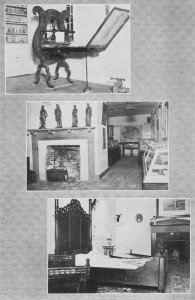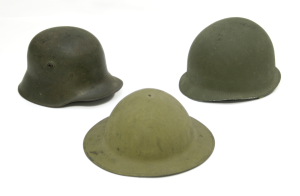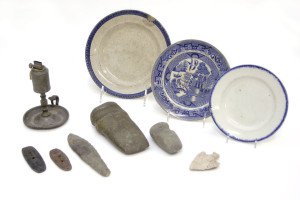One hundred years ago, as the First World War raged in Europe, the Mackinac Island State Park Commission began the long process of creating museum exhibits to share the rich history of the Straits of Mackinac region. Although the United States would not enter the war until 1917, the conflict would eventually play a role in the commission’s first permanent exhibits.
In 1914, nearly 20 years after it was founded, the commission began to plan its first museum exhibit. Located inside the Officers’ Stone Quarters at Fort Mackinac, the small exhibit space was set aside as a state museum. The museum exhibited a variety of Mackinac-related artifacts, the first of which were donated from the collections of Commissioner Edwin Wood. After the United States entered the world war, the commission specifically sought artifacts to help document Michigan’s role in the conflict. In 1919, the commission sent out a request via Michigan’s Congressmen asking for “relics of the war with Germany.” Helmets, machine guns, and other artifacts from the war were dutifully collected and placed on display in the Stone Quarters, which served as the state’s military museum.
However, the commission lacked the ability to properly care for the Stone Quarters exhibits, prompting one commissioner to report that “the fort museum is a pitiful imitation of the real thing” in 1933. As a result, the commission began to carefully catalog all of its artifacts, and designed improved displays in the Stone Quarters, Wood Quarters, and barracks buildings at Fort Mackinac. This movement towards a professional museum culminated in 1958, when the commission first sold bonds to finance exhibits and interpretive programs.  These programs continue today at Fort Mackinac as well as the several other historic sites and museums administered by the commission. Although no longer on public display (they are housed in a specially-designed collections storage complex on Mackinac Island), the World War One artifacts which were first exhibited nearly a century ago represent the first steps towards the commission’s modern museum programs, which educate hundreds of thousands of Mackinac visitors every year.
These programs continue today at Fort Mackinac as well as the several other historic sites and museums administered by the commission. Although no longer on public display (they are housed in a specially-designed collections storage complex on Mackinac Island), the World War One artifacts which were first exhibited nearly a century ago represent the first steps towards the commission’s modern museum programs, which educate hundreds of thousands of Mackinac visitors every year.









